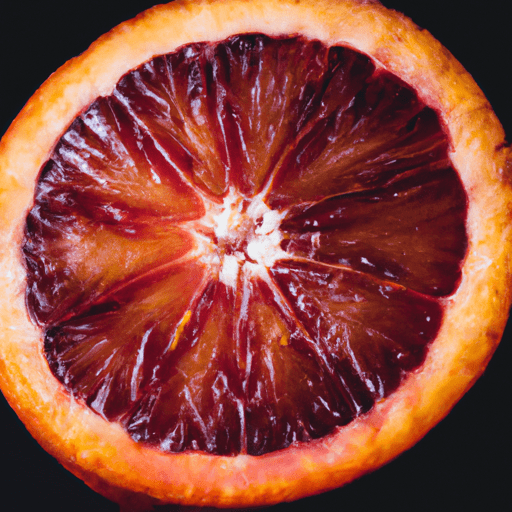Rediscovering the Charm of Blood Oranges
As we explore the diverse world of citrus fruits, one stands out for its mesmerizing hues and unique flavor — the blood orange. With its crimson flesh and tangy-sweet taste, the blood orange captivates both the eyes and taste buds. In this blog post, we will delve into the wonderful world of blood oranges, exploring their taste, culinary uses, nutritional value, and intriguing history.
A Taste Sensation
Peel back the rough skin of a blood orange, and you’ll be greeted with a burst of vibrant, deep red flesh. The flavor is a delightful dance between sweet and tangy, with hints of raspberry and strawberry. The complex undertones of the fruit lend it a more intense and robust taste compared to regular oranges or even other citrus fruits.
Culinary Versatility
Beyond their striking appearance, blood oranges bring a world of possibilities to the kitchen. Their tangy yet sweet flavor profile makes them perfect for both sweet and savory applications. Here are a few popular ways to incorporate blood oranges into your culinary creations:
1. Fresh Juices and Cocktails
With its gorgeous color and zesty taste, blood orange juice is a must-have for refreshing beverages. From simple fresh-squeezed juice to tantalizing cocktails like blood orange margaritas or spritzers, this vibrant citrus fruit adds a burst of flavor to any libation.
2. Vibrant Salads
Add a pop of color and a burst of tanginess to your salads by incorporating blood oranges. Their unexpected flavor elevates ordinary green salads to extraordinary culinary experiences. Pair slices of blood orange with arugula, fennel, and toasted nuts, and drizzle with a citrus vinaigrette for a refreshing and visually stunning salad.
3. Desserts and Baked Goods
Blood oranges are a delightful addition to desserts, awakening the taste buds with their unique flavor. Their vibrant juice can be transformed into sorbets, granitas, or indulgent custards. For a surprise twist, incorporate finely chopped blood orange zest into cakes, pastries, or even a batch of homemade marmalade.
Nutritional Powerhouse
Not only do blood oranges wow us with their visual appeal and exceptional taste, but they also pack a punch in terms of nutritional value. Rich in vitamin C, folate, and anthocyanins, blood oranges offer an array of health benefits. Vitamin C is essential for immune health and collagen production, while anthocyanins are powerful antioxidants known for their anti-inflammatory properties.
A Storied History
The captivating allure of blood oranges extends beyond their culinary delights. Although the exact origin of blood oranges is murky, it is believed they first flourished in the warm Mediterranean climates of Sicily and Spain. Over time, they spread to other regions, becoming popular and sought-after fruits around the globe.
Fascinating Facts
Here are a few interesting facts about blood oranges:
- The characteristic red hue of blood oranges comes from the presence of anthocyanins, natural pigments usually found in berries.
- Blood oranges are known by different names worldwide, including “sanguine,” “Moro,” and “Maltese.”
- The anthocyanins in blood oranges develop best in cooler temperatures, resulting in more intense color and flavor during colder winter months.
Now that you’re armed with a plethora of knowledge about blood oranges, it’s time to embark on your own culinary adventure. Embrace the captivating flavor and vivid color of this citrus gem in your cooking and let it transport you to a world of culinary brilliance!
Origin of Blood Oranges:
- Blood oranges (Citrus × sinensis) are believed to have originated in Italy, specifically in the southern regions of Sicily and Calabria.
- The exact history and origin of blood oranges are not well-documented, but some theories suggest that they may have been a natural mutation of sweet oranges that occurred several centuries ago.
Common Uses:
- Blood oranges are highly sought after for their unique flavor and vibrant red flesh, which sets them apart from other orange varieties.
- They are commonly used in both sweet and savory dishes, adding a beautiful color and a tangy-sweet taste.
- Blood oranges are often used in fresh fruit salads, juices, cocktails, and marmalades, as well as in baking and desserts like cakes, tarts, and sorbets.
- Their distinctive flavor makes them a popular choice for adding depth to sauces, dressings, and marinades.
Nutritional Benefits:
- Blood oranges are a good source of vitamin C, which supports immune health and acts as an antioxidant in the body.
- They also contain dietary fiber, which aids in digestion and helps maintain a healthy weight.
- Blood oranges are rich in anthocyanins, which are natural pigments that give them their red color and have been associated with potential health benefits such as reducing inflammation and promoting heart health.
- Additionally, blood oranges provide potassium, folate, and other essential nutrients.
Unique Properties and Historical Significance:
- The distinct red color of blood oranges comes from the same phytonutrients responsible for the purple and red colors found in some berries and other fruits.
- The intensity of the red color in the flesh of blood oranges can vary depending on factors like the variety, climate, and ripeness.
- The most famous variety of blood orange is the “Moro,” known for its deep red flesh and strong citrus flavor.
- Blood oranges have gained significant popularity in recent years and have become a symbol of the Mediterranean cuisine, particularly in Italy where they are a widely recognized ingredient.
- Due to their limited growing regions and short growing season, blood oranges are often considered a seasonal delicacy. Their availability is typically from December to March in most regions.
Please note that while blood oranges are generally safe and nutritious, anyone with specific dietary concerns or medical conditions should consult with a healthcare professional for personalized advice and guidance.




Use the share button below if you liked it.
It makes me smile, when I see it.